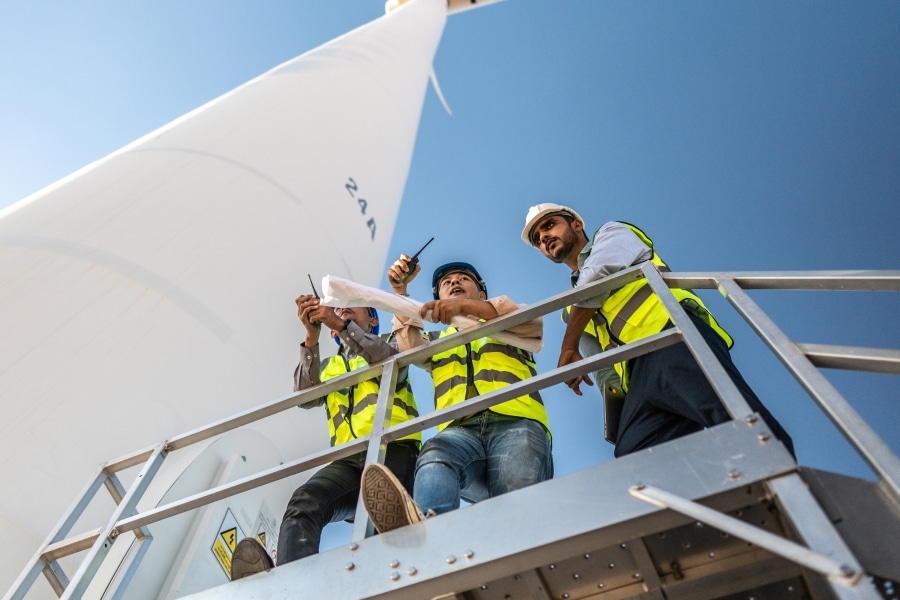Given construction’s historic reputation as a manual and labor-intensive industry, the sector isn’t the most obvious example by which to judge the merits of remote work.
The industry has long been seen as a slow adopter of new working practices and technology. However, the COVID-19 pandemic triggered, or was at least a catalyst for, a much-needed shift in attitudes towards remote construction work.
In the initial stages of the pandemic in early 2020, building sites were effectively shut down as part of government-imposed lockdowns. The impact was worldwide. Estimates suggest that global construction activity fell by more than 3% in 2020. In China it was said to have been more than 5%.
But as much as the pandemic blunted economies around the world, it also prompted many industries to reconsider how they operated and the potential benefits of a flexible working policy. Construction was no exception, and as activity slowly ramped up again in 2021, the sector became receptive to change, building on pockets of progress that were already underway.
Being more open toward flexible and remote construction work followed in the wake of the belated recognition that technology, particularly digitization, could empower companies to deliver more, better and efficiently.
Balancing commercial considerations with flexibility at work
One of the hurdles to flexible working practices in construction is the perception that it would risk the commercial priorities that require projects be delivered on time and within budget.
Emma Stewart, co-founder of flexible working consultancy Timewise, believes operational demands can limit “more innovative approaches to improving working practices and well-being from being trialed, however good leaders’ intentions may be.”
Working with construction trade group Build UK, Timewise ran a series of pilot schemes with four leading contractors – BAM Construct UK, BAM Nuttall, Skanska UK and Willmott Dixon – to understand what flexible working might entail, how it might be implemented, its potential benefits and the challenges it posed.
The pilots revealed some interesting findings, which were published in a report, “Making Construction A Great Place To Work: Can Flexible Working Help?” The number of people who agreed with the statement: “My working hours give me enough time to look after my own health and well-being” leapt from 48% to 84%, while many workers – perhaps predictably – welcomed the opportunity to spend more time at home with their family.
The trials also showed that committing to flexible working wasn’t a barrier to delivery. Says Emma: “All of the pilot projects remained broadly on time and within budget.”
She highlighted one site supervisor who’d commented: “People are more energized and working faster. If you are being paid for a 10-hour shift you will make it last 10 hours, but if there is an incentive to still get paid a full shift but finish quicker, you are focused to get the work done.”
Which technologies enable remote construction work?
Going hand in hand with the growing popularity of flexible working is an acknowledgment around the role technology can play in making workers more productive, helping them do their jobs in greater safety, often from anywhere, and enabling projects to be delivered to higher standards of quality and cost-effectiveness.
The increasing use of digital reporting, using software systems like Bluebeam, enables employees to work remotely with ease: accessing plans in the field, marking documents and generally keeping tabs on the progress of construction activity at all times of the day – and even night, if necessary.
The deployment of robot technology, such as Boston Dynamics’ ‘Spot’ and drones to conduct surveys of hard-to-reach places on sites, is another obvious benefit, allowing workers to assess the progress of construction work without the risk of coming to harm themselves.
Other technologies are playing their part in allowing greater flexibility and remote working. Virtual reality hardware enables designers to “walk” through a building before it has left the drawing board, while digital twins can replicate a real asset in 3D, allowing users to monitor how it performs without having to leave their office.
Overcoming constraints and challenges of new ways of working
Inevitably there must be shifts in attitude if these approaches are to work effectively. When considering a flexible working policy, Stewart of Timewise says managers need to be prepared to adjust working practices, “including output-based scheduling, late starts and early finishes, and allowing staff to cover for each other and to take back unpaid overtime.”
There are obvious constraints around flexible working in “frontline” construction roles, Stewart acknowledges, “including site operating times, workers’ long travel times to reach site, client expectations and the differing pay methods and interests of the multiple layers of directly employed, self-employed and subcontracted workers,” and these will need to be accommodated.
Firms will need help in creating a model that will work for them, she says, noting that roles that are destined to become flexible will need to be designed in such a way that staff can function comfortably with the changes being made.
There is, according to a study by researchers at the University of Northumbria, Newcastle, “a general appetite for remote working on a flexible basis [across construction] where a mix of ‘on-site’ and ‘off-site’ arrangement was deemed practical.”
This, the study concluded, “could potentially unlock significant time and cost savings as well as productivity gains.” The main factors affecting remote working were the availability of interconnected systems, “allowing efficient communication and digital infrastructure that enable automated processes,” it added.
Will flexible working in construction become the new normal?
So, what is the outlook for flexible work in construction? When weighing the advantages and disadvantages of flexible working, those who have dipped their corporate toes in the water have sounded positive.
According to Andrea Singh, executive and HR director for BAM Construct UK, one of the four firms to take part in Timewise’s flexible working pilot programs, the program is giving people a better work-life balance and is making construction an attractive career choice.
“Our default position now is that flexibility is possible and desirable, and to prioritize a devolved, team-based decision-making culture to empower it so that it continues to support our business objectives,” Singh said.
“We now ask, ‘How can we make flexibility work?’ not, ‘Can we make it work?’ We’ve provided a framework for our teams without lots of rules and hurdles. Managers can find flexible working approaches that work for their team, their clients and their job.”











